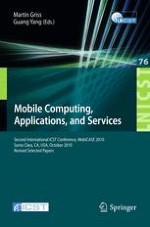2012 | Buch
Mobile Computing, Applications, and Services
Second International ICST Conference, MobiCASE 2010, Santa Clara, CA, USA, October 25-28, 2010, Revised Selected Papers
herausgegeben von: Martin Gris, Guang Yang
Verlag: Springer Berlin Heidelberg
Buchreihe : Lecture Notes of the Institute for Computer Sciences, Social Informatics and Telecommunications Engineering
